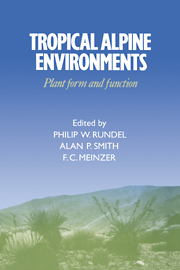Book contents
- Frontmatter
- Contents
- List of contributors
- Preface
- 1 Introduction to tropical alpine vegetation
- 2 Tropical alpine climates
- 3 Páramo microclimate and leaf thermal balance of Andean giant rosette plants
- 4 Comparative water relations of tropical alpine plants
- 5 Cold tolerance in tropical alpine plants
- 6 Anatomy of tropical alpine plants
- 7 Environmental biology of a tropical treeline species, Polylepis sericea
- 8 Morphological and physiological radiation in páramo Draba
- 9 Sediment-based carbon nutrition in tropical alpine Isoetes
- 10 Functional significance of inflorescence pubescence in tropical alpine species of Puya
- 11 Turnover and conservation of nutrients in the pachycaul Senecio keniodendron
- 12 Soil nutrient dynamics in East African alpine ecosystems
- 13 An overview of the reproductive biology of Espeletia (Asteraceae) in the Venezuelan Andes
- 14 Population biology of Mount Kenya lobelias
- 15 Population biology of Senecio keniodendron (Asteraceae), an Afroalpine giant rosette plant
- 16 Population dynamics and flowering in a Hawaiian alpine rosette plant, Argyroxiphium sandwicense
- 17 Plant form and function in alpine New Guinea
- 18 Alpine herbivory on Mount Kenya
- 19 Biotic interactions in Hawaiian high elevation ecosystems
- 20 Tropical alpine ecology: progress and priorities
- Index
13 - An overview of the reproductive biology of Espeletia (Asteraceae) in the Venezuelan Andes
Published online by Cambridge University Press: 21 October 2009
- Frontmatter
- Contents
- List of contributors
- Preface
- 1 Introduction to tropical alpine vegetation
- 2 Tropical alpine climates
- 3 Páramo microclimate and leaf thermal balance of Andean giant rosette plants
- 4 Comparative water relations of tropical alpine plants
- 5 Cold tolerance in tropical alpine plants
- 6 Anatomy of tropical alpine plants
- 7 Environmental biology of a tropical treeline species, Polylepis sericea
- 8 Morphological and physiological radiation in páramo Draba
- 9 Sediment-based carbon nutrition in tropical alpine Isoetes
- 10 Functional significance of inflorescence pubescence in tropical alpine species of Puya
- 11 Turnover and conservation of nutrients in the pachycaul Senecio keniodendron
- 12 Soil nutrient dynamics in East African alpine ecosystems
- 13 An overview of the reproductive biology of Espeletia (Asteraceae) in the Venezuelan Andes
- 14 Population biology of Mount Kenya lobelias
- 15 Population biology of Senecio keniodendron (Asteraceae), an Afroalpine giant rosette plant
- 16 Population dynamics and flowering in a Hawaiian alpine rosette plant, Argyroxiphium sandwicense
- 17 Plant form and function in alpine New Guinea
- 18 Alpine herbivory on Mount Kenya
- 19 Biotic interactions in Hawaiian high elevation ecosystems
- 20 Tropical alpine ecology: progress and priorities
- Index
Summary
Introduction
Communities of Espeletia, known locally as ‘frailejones’, constitute the dominant and most striking physiognomic elements of the high montane páramo vegetation of the northern Andes (Figure 13.1). Different species occupy a variety of habitats, ranging from cloud forest, as low as 1500 m in elevation, to close to the upper limit of plant growth, at 4700 m. With over 130 currently recognized species and a wide diversity of life forms and other morphological features, Espeletia has been noted as one of the foremost examples of adaptive radiation in plants (Carlquist 1974).
One of the keys to understanding the ways that groups such as Espeletia have successfully colonized different habitats in high, tropical mountains lies in a study of their reproductive systems. Vegetative reproduction in Espeletia is rare and occurs to a limited extent in just a few species that produce axillary rosettes close to the ground (Cuatrecasas 1979). Seed dispersal is also very restricted, due to the absence of a pappus or other specialized dispersal structure (Cuatrecasas 1976; Smith 1981; Guariguata 1985). Thus, the breeding and pollination systems are the major determinants of gene flow in Espeletia and constitute an important factor affecting the genetic structure of populations.
The little previous information on the reproductive biology of Espeletia was obtained from studies undertaken in the páramos of Edo. Mérida, Venezuela.
- Type
- Chapter
- Information
- Tropical Alpine EnvironmentsPlant Form and Function, pp. 229 - 250Publisher: Cambridge University PressPrint publication year: 1994
- 10
- Cited by



